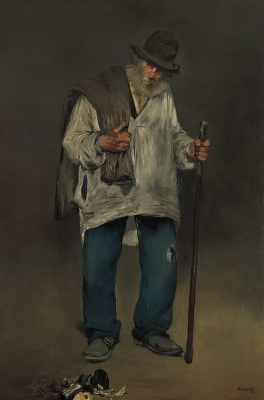Gospel in Art: No one puts a piece of unshrunken cloth on to an old cloak

The Ragpicker, by Edouard Manet, 1869 © Norton Simon Museum, Pasadena, California / Wikimedia Commons
Source: Christian Art
Gospel of 6 July 2024
Matthew 9:14-17
John's disciples came to him and said, 'Why is it that we and the Pharisees fast, but your disciples do not?' Jesus replied, 'Surely the bridegroom's attendants would never think of mourning as long as the bridegroom is still with them? But the time will come for the bridegroom to be taken away from them, and then they will fast. No one puts a piece of unshrunken cloth on to an old cloak, because the patch pulls away from the cloak and the tear gets worse. Nor do people put new wine into old wineskins; if they do, the skins burst, the wine runs out, and the skins are lost. No; they put new wine into fresh skins and both are preserved.'
Reflection on the painting
Decades ago, it was common practice to patch clothes. When a jacket had a hole or a jumper was damaged, instead of discarding it, we would repair it. Iron-on patches or carefully sewn bits of fabric were used to mend the garment. These patches were often quite noticeable, a testament to the garment's extended life. This practical approach stands in stark contrast to today's throwaway culture, where damaged clothing is often simply discarded. A vivid example of our old tradition of mending clothes can be seen in Edouard Manet's painting, 'The Ragpicker,' where the trousers display prominently an obvious patch.
Ragpickers are a now-obsolete profession. It involved sifting through the remnants of daily life. Ragpickers collected not only rags, which were sold to paper manufacturers, but also kitchen scraps, soap, and other discarded items left out for trash collectors. Though sorting garbage might seem like work for the truly destitute, these scavengers were regulated, semi-professional recyclers of city waste, recognised as a distinct social group. Our painter, Manet, experienced his own sense of alienation and rejection from the established art circles, may have identified with his embattled subject. Both the artist and the ragpicker can be seen as bohemians, operating on the margins of society and earning a living by utilising the mundane aspects of everyday life. The small still-life element in the lower foreground of this painting-a pile of opened oyster shells, coupled with a broken champagne bottle and lemon peels-symbolises this shared creative act and the ingenuity found in making use of what others discard.
Today's Gospel reading talks about not 'putting a piece of unshrunken cloth on to an old cloak'. Jesus is basically asking us if our faith is just a 'patch' on a normal way of life we got used to? We may well go to Sunday Mass, but does anything really change deeply when we are there? Do we let ourselves be open to being changed? Jesus does not want to be merely a 'patch' on a routine way of life that we have got used to. He wants to wrap a whole new cloak around us!
LINKS
Gospel in Art: https://christian.art/
Today's Reflection: https://christian.art/daily-gospel-reading/matthew-9-14-17-2024/


















